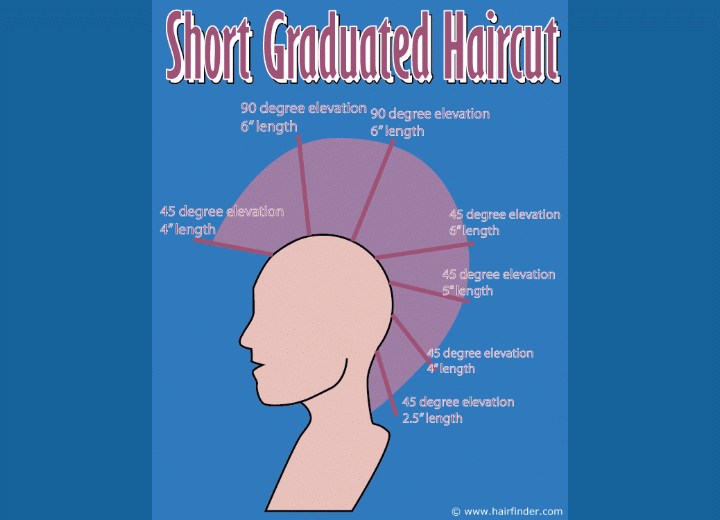How to Cut a Short Graduated Haircut

By definition, a "graduated haircut" is an "effect or haircut that results from cutting the hair with tension, and low to medium elevation or overdirection." Many graduated cuts also have a stacked area around the exterior.
Just like other haircuts, the term "short graduated cut" can refer to a wide variety of specific looks, since the key techniques of the cut consist of tension in the segment being cut and the use of 45-degree or smaller cutting angles and overdirection.
For a short graduated cut, the fringe will be elevated to a 45-degree angle and cut using a vertical cutting line. The top and crown sections are going to be elevated straight out from the head (at 90 degrees) and cut, and the side and nape sections will be elevated to 45 degrees and cut with vertical cutting lines as well. The diagram shown gives you the lengths to create a classic short graduated cut.
To start, you should:
1. Section the hair in a standard seven-section parting, separating the sides and top into three sections. The crown should be divided into two equal sections, roughly triangular in shape, and the nape area should be divided into two equal halves down the center. Click here for illustrations on sectioning the hair for cutting.
2. Determine your desired lengths for the front, back, and sides, and cut a small guide to mark this length. Cross-check your side lengths by bringing them together in the front or back to ensure they line up correctly.
3. Start by cutting the forward sections first. This allows you to secure the hair away from the client's face once you're finished. Use a 45-degree elevation at the fringe and forward top section, and increase the elevation to 90 degrees as you move back along the head.
4. Move on to the back section next and cut the perimeter length as desired. Start from the back center and work towards the left and right, cutting the perimeter to achieve the desired style. Continuously check the side cuts to ensure balance and evenness in the overall cut.
5. Lower the sectioned hair one-half section at a time and cut it using a 45-degree elevation and a vertical cutting line. Begin from the center back and alternate between slices towards each side, ensuring balanced cutting. As you finish cutting a half-section, lower more hair and repeat the process.
6. Once you have cut all the sections of the hair, cross-check the layering by combing slices in the opposite direction of the hair's cut. Look for any pointy angles or protrusions that indicate missed hairs during the slicing and cutting process. Trim these away to blend them with the rest of the layers.
After the hair is cut, style it as desired. Depending on the specific lengths of the cut, the hair can be blow-dried and styled, curled with a wet set, or using heated tools.
©Hairfinder.com
See also:
How to cut a short stacked bob
What are the benefits of a uniform layers, short graduation, long graduation and a one length cut?